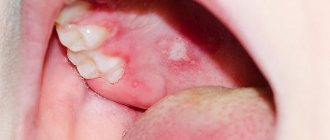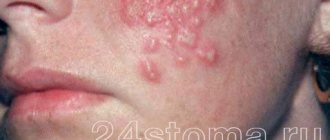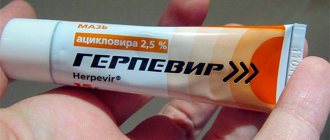Pediatrician Mikhail Nikolsky: Herpes - to treat or not to treat
Alexandra Petrovskaya: Good afternoon. This is a program for the biggest ones. With us in the studio is pediatrician and candidate of medical sciences Mikhail Nikolsky. Mikhail Andreevich, hello.
Mikhail Nikolsky: Good afternoon.
A.P.: We have gathered here today about your scientific work on herpes types 6 and 7. Let's try to explain to the listeners what it is, and, most importantly, where these types come from, and what other types - the first, second, third and so on - go up to 6 and 7.
M.N.: In total, there are 8 or 9 types of herpes, depending on how you count. The first and second types are common herpes, which causes cold sores on the lips. The third type is the herpes zoster virus, which causes chickenpox or shingles in adults.
A.P.: So what we call chickenpox is, in fact, the same herpes?
M.N.: Not the same, it’s a completely different herpes, but also herpes.
A.P.: By what principle are they all united under this name?
M.N.: It's difficult. When scientists studied the DNA of these viruses, it turned out that they all had similar related features. The fourth type, Epstein-Barr virus, causes infectious mononucleosis. The fifth type is what everyone knows as cytomegalovirus. These are also often infections, mostly for children.
And finally, type 6 and 7 are what I do. Most often they cause roseola in children - a three-day fever or sudden exanthema. Next comes the eighth type of herpes, it occurs in Kaposi's sarcoma. This is a serious disease that predominantly occurs in HIV-infected patients.
A.P.: Besides the common name and some similarities in DNA, what else unites them? Maybe there are common methods of therapy or similar effects of the virus on the body?
M.N.: Firstly, unlike many other viruses, there is a medicine against herpes. This is what makes these viruses different from others in many ways because there are no cures for a huge number of viruses.
A.P.: What about all these fashionable antiviral drugs that are advertised everywhere?
M.N.: Everything that is advertised on TV is, unfortunately, most likely fake.
A.P.: Fakes are prohibited.
M.N.: Fakes are prohibited, but, apparently, advertising of drugs without proven effectiveness is allowed.
A.P.: This is a topic for a separate program.
M.N.: This is a problem for our country, because in our country fakes have even found their way into clinical recommendations. And we treat people with all these “bullshit drugs.” Moreover, we are obliged to treat them, because we have appropriate clinical recommendations.
A.P.: Is someone lobbying for this?
M.N.: Of course, this is lobbied for, it is paid for. And what to take if, excuse me, we have one of the members of the Russian Academy of Sciences - a homeopath.
A.P.: In these words you can feel your contempt for homeopathy.
M.N.: From the point of view of a clinical physician, to some extent, yes, contempt, this is true.
Let's return to herpes. They have a unique feature. After a person becomes ill with a primary herpes infection, these viruses do not leave the human body. All herpes that a person encounters in life remain with him forever.
A.P.: I came across the statement that it is difficult to meet a person on Earth over 10 years old who does not have antibodies to one or another type of herpes.
M.N.: And not only antibodies, but even the herpes themselves. In almost all people after a certain age, one or another herpes can be found in saliva, blood or other tissues. This is the problem with diagnosing them - doctors very often get confused. Colleagues, out of ignorance, but with the best intentions, prescribe, for example, saliva tests for frequently ill patients for the Epstein-Barr virus, cytomegalovirus, herpes type 6, type 7, and find them in the saliva. And this is the norm.
A.P.: Are they starting to treat?
M.N.: Yes, absolutely right. The patient does not know that this is the norm. He sees that he has a “terrible” test, that such and such a number of these herpes have been found, and the doctor, most likely, out of ignorance and lack of understanding of this problem, begins to treat normal carriers of herpes. And what does he treat? He treats with the same fuflomycins. And nothing happens.
A.P.: Bottom line – there is no need to treat herpes?
M.N.: It is necessary if it caused a serious illness - and all herpes in certain cases can cause serious illnesses. For example, herpes type 6 is a common cause of severe conditions in patients after a bone marrow transplant. If herpes after a bone marrow transplant has worsened against the background of a decrease, the actual destruction of one’s own immunity, then therapy necessarily requires powerful antiviral agents.
Well, take chickenpox – it would seem a harmless disease. But after 11 years it is difficult and can have consequences. Therefore, it is believed that if the patient is under 11 years of age, it often goes away on its own. And if you are over 11 years old, then it is better not to risk it, but to prescribe acyclovir.
A.P.: Is this a drug with proven effectiveness?
M.N.: Yes, it acts specifically on the chickenpox virus.
A.P.: It turns out that herpes, which is always in the body, at some point gets worse. For example, I heard about herpes type 6, that this is a typical disease for children under 2-3 years of age. It turns out that no.
M.N.: The fact is that herpes type 6 is the most common infection that always causes sudden exanthema or three-day fever or roseola. In principle, it is a very understandable infection: the child has a high fever for three days, then a typical maculopapular rash appears. Within two days it disappears on its own and the person recovers.
The infection itself can occur even through an ordinary kiss, as happens with many herpes. That is, the virus can enter the child’s body through contact with the saliva of the mother, grandmother, or any adult, who are usually the carrier of all herpes. And so the child suffers this primary infection through the human herpes virus type 6, and after that the human herpes type 6 remains in this child forever. And it won’t go anywhere, and there’s no way to get rid of it.
But it needs to be treated only in one situation - if it has caused some kind of serious illness, which almost never occurs in healthy people. Only for severe immunodeficiencies, which usually occur during organ and tissue transplantation. There are situations when intensive treatment of herpes type 6 is required.
In all other cases, there is no need to shock-treat it. And we must keep in mind that herpes is a very fashionable topic now. Herpes virus type 6 is easy to find, which means it can be presented for almost any disease as a possible diagnosis. And many doctors use this. For example: “I don’t know what’s wrong with you. Let’s look for what you definitely have.” And here is herpes type 6 - it definitely exists, and it is there.
A.P.: Another such moment. What other diseases can be associated with herpes viruses that are present in the body?
M.N.: As I already said, herpes types 6 and 7 “classically” cause roseola in children. Herpes type 6 and sometimes, but rarely, type 7 are also associated with febrile seizures in children. There are studies that show a connection between certain types of epilepsy and human herpes virus type 6. So it turns out that herpes type 6 actually causes a type of epilepsy.
A.P.: This virus is present in almost everyone’s body, but not everyone has epilepsy. That is, this suggests that there is no direct connection; there are other factors influencing the appearance of this disease?
M.N.: Of course, there are many factors here. For example, two people caught the same infection: but one had a runny nose, and the other had meningitis. But the infection is the same. Of course, there are many factors involved.
There was also a study that associated human herpes viruses 6 and 7 with other diseases, suggesting a link with multiple sclerosis. But this has not been proven. This is already a field of science, but we do not have clear indications that herpes is exactly what causes multiple sclerosis.
A.P.: During the program, we talked briefly about all herpes and outlined all the important points. And, concluding the conversation, I want to return to the beginning. What questions does science face today in this area?
M.N.: By the way, I forgot to say that a special form of human herpes type 6 is the chromosomal integrated form of this virus, when herpes type 6 is introduced into the human chromosome and begins to be inherited by all generations.
Now we have received a grant in St. Petersburg. We conduct free examinations of everyone for certain indications for the presence of chromosomally integrated human herpes type 6. It is precisely the presence of chromosomally integrated human herpes type 6 that may provide links with certain diseases. It turns out that almost 1% of the world's population has a chromosomally integrated virus built into its genome.
A.P.: Okay. Remembering my student years, what hypothesis do you have in this scientific research? If something, then what?
M.N.: We are currently recruiting a reference group, we are looking for people, we are examining them. I personally am now most interested in whether there are clinical manifestations of chromosomal integration of human herpes type 6 in newborns. In my opinion, this is the most interesting concept; no one in the world has yet developed this direction. So far there are preliminary results, but I’m not ready to announce them yet.
A.P.: Our guest was Mikhail Nikolsky, a pediatrician and candidate of medical sciences. Thank you and have a nice day everyone!
HERPETIC INFECTION
You chavoy are out of your mind!
There's a pimple on my lip!
L. Filatov
Herpes infection is not a specific disease. This is a term that unites a whole group of diseases and requires some clarification.
Viruses, like all other organisms, are divided by scientists into families, genera, and individual species. Currently, about 80 similar representatives of the herpes virus family have been discovered in nature, 7 of them isolated from humans.
These viruses, although similar to each other, cause diseases that are very different in terms of timing, clinical manifestations, and danger to the human body. By the way, we have already met three diseases - not at all similar, but they are all caused by viruses of the herpes group. These are chicken pox, sudden exanthema and infectious mononucleosis, just discussed.
The time has come to talk about a special virus, perhaps the most widespread, capable of causing a wide variety of diseases, sometimes deadly. It is called “herpes simplex virus”.
According to numerous studies, from 65 to 90% of all inhabitants of planet Earth are infected with the herpes simplex virus! Infection occurs in childhood, by contact or airborne droplets, and by the age of 6, about 80% of children already have the herpes virus in their bodies.
The virus, as it should be, penetrates inside the cells and remains there in an inactive state for life - that is, if infection with the virus has occurred, no medicine can completely get rid of it. But there seems to be nothing wrong with this - an inactive virus does not cause any particular harm. At the same time, if certain accompanying conditions occur, accompanied by a decrease in immunity (cold, other infectious disease, stress, physical fatigue, malnutrition, lack of vitamins, injury, etc.), the virus seems to wake up, begin its dirty work and cause illness .
One of the most typical manifestations of herpes simplex is a rash on the lips, more precisely at the border of the skin and the lip itself. People simply call these itchy blisters “fever.” It is easy to notice that in some people (children) these same fevers occur often, in others - very often, in others - they never occur. It all depends on immunity, on the general level of health of a particular person.
We have already written several times about the main nonspecific antiviral protein - interferon. The fact is that the body reacts differently to each virus, producing a certain amount of interferon. In the language of scientists, each virus has “individual interferonogenic activity,” and readers will forgive me for my very clever words. The particular “harmfulness” of the herpes simplex virus lies precisely in the fact that it hardly stimulates or to a very small extent stimulates the production of natural interferon. Hence the instability and insufficiency of immunity, frequent repetitions (relapses) of the disease.
“Fever” on the lips is still the flowers of the herpes simplex virus. Manifestations of the disease can be much more serious - eye damage, widespread lesions of the skin and oral mucosa (stomatitis), extensive rashes on the genitals (so-called genital herpes), pneumonia and the most terrible manifestation of infection - herpetic encephalitis - severe inflammation of the brain with unpredictable, but, as a rule, very sad consequences.
- The severity of any manifestations of herpetic infection is determined, first of all, by the state of the immune system! Once again we have to pay attention to the fact that the main method of prevention is a natural lifestyle that ensures the normal functioning of the immune system.
- Currently, there are drugs that can selectively suppress the reproduction of herpes viruses in the human body. The most famous is acyclovir (synonyms are herpevir, virolex, zovirax), and its appearance is the same revolution in medicine as the discovery of penicillin. Acyclovir is used topically, to treat rashes (ointments, creams, jellies), courses of treatment (sometimes very long) are carried out with tablets, and for herpetic encephalitis and other particularly severe variants of the disease, the drug is administered intravenously.
- Treatment of herpes infection usually involves the use of interferon. Not those well-known and relatively cheap nasal drops, but expensive and truly effective forms of interferon that are administered by injection. In addition, special medications are used that repeatedly increase the production of interferon in the body (cycloferon, neovir).
- Herpetic infection, and this is obviously curable. It is impossible, as we already understood, to completely eradicate the virus, but forgetting about its existence is quite possible. The main drawback of all methods of treating herpes infection without exception is the discrepancy between the income of our compatriots and the cost of effective medicines.
- The difficulty of treating herpes infection is not only the cost of medications. The treatment is long-term, carried out according to certain schemes that take into account the state of immunity, concomitant diseases, and the variant of infection. Parents just need to know the main thing: “herpetic little things” - like blisters on the lips - can sooner or later turn into a more serious problem, and herpes is not a sore when self-medication can lead to success. Hence the urgent need for consultation with a competent specialist and a full examination.
author Komarovsky E.O. book Child's health and the common sense of his relatives published 02/24/2010 18:40
Epstein-Barr virus in children
Epstein-Barr virus in children manifests itself in the form of infectious mononucleosis, ARVI or chronic disease.
For most people, herpes is a “cold on the lips.” However, the Epstein-Barr virus is a type of herpes, but type IV and a “relative” of chickenpox, cytomegalovirus and herpes simplex. The Epstein-Barr virus (like other members of the herpes family) is very widespread, up to 95% of the world's population are its carriers. In 80% of cases, infection occurs in childhood, most often before 3 years. Once an infectious agent enters the body, it remains there for life.
The virus can only reproduce in human cells. Some cells undergo changes under the influence of the disease. The altered cells allow the virus to remain in the human body forever in a “dormant” state. When the host’s immunity decreases, the microorganism is activated, begins to multiply and conquers new cells, which manifests itself as signs of disease
Viruses are transmitted from a sick child to a healthy one; the mode of transmission is airborne droplets from sneezing, coughing and talking; contact when using shared combs, toothbrushes, towels; through kisses. Therefore, the disease caused by the Epstein-Barr virus is called “kissing disease.” Transmission from mother to child during pregnancy is possible. The onset of the disease can be acute or hidden. Often a person does not even suspect that he has become infected.
Infectious mononucleosis in children
Infection caused by the Epstein-Barr virus, otherwise called EBV, in 80% of cases in children occurs as an acute respiratory viral infection, and in 20% infectious mononucleosis develops, a disease associated primarily with the Epstein-Barr virus (but do not forget that the culprits may be cytomegalovirus, herpes virus type 6, etc.). Unlike other pathogens that inhibit the development and reproduction of cells, EBV stimulates changes in cells of the immune system, in particular B-lymphocytes. For this reason, typical clinical signs are observed:
- Enlarged tonsils (tonsillitis)
- Difficulty in nasal breathing
- Enlargement of different groups of lymph nodes: more often cervical, less often axillary, inguinal
- Enlarged liver and spleen
- Increased body temperature
Sometimes chronic EBV infection develops. Parents should be alert to the following signs:
- Low-grade fever (up to 37.9 degrees) for a long time (more than a month)
- Weakness, sweating, sleep disturbances, the child has become capricious
- Previously uncharacteristic headaches, dizziness
- Heaviness in the right hypochondrium, the appearance of yellowness of the sclera and skin
Diagnosis of disease caused by EBV
If you see these symptoms in your child, what should you do next? The best decision is to see a doctor, and he will prescribe the following tests:
- Clinical blood test with leukocyte formula
- PCR research
- Antibodies to Epstein-Barr virus
- If necessary, biochemical tests to assess liver and kidney function
Laboratory tests for mononucleosis
Clinical blood test with leukocyte formula (with mandatory microscopy of a blood smear)
The appearance of reactive lymphocytes in a blood test of more than 10% (usually 60-80%) allows the doctor to suspect mononucleosis and continue to search for its cause.
The targets for the Epstein-Barr virus in the human body are lymphocytes, which change under the influence of the pathogen and become similar in structure to other cells - monocytes. Such cells are called reactive lymphocytes, or atypical mononuclear cells (the name of the disease, mononucleosis, comes from the name of the cells).
PCR research
The PCR method is aimed at identifying the DNA of the Epstein-Barr virus, that is, its genetic material. It is relevant specifically in childhood, during the period of primary infection - with mononucleosis. Blood, urine, saliva, or oropharyngeal swab are examined.
In the chronic course of the disease, PCR will not be so informative, because if the pathogen has entered the body, it remains for life, and detecting it in the blood or tissues will only indicate that the body is infected, but when the infection occurred - a week or 2 years ago - the answer we will not get the answer to the question. To do this, we need to study human immunity by examining antibodies.
Antibodies to Epstein-Barr virus
To understand the essence of the study, let’s figure out what happens in the body in response to an infectious agent?
For each type of pathogen, the immune system produces immunoglobulins (Ig) - specific proteins aimed at recognizing and further protecting against the disease upon encounter.
Immunoglobulins M (IgM) appear first; they are markers of the initial encounter with the pathogen and disappear from the blood after about a month. But during EBV infection, IgM immunoglobulins can persist for a long time, since EBV affects immune cells.
Immunoglobulins G (IgG) are persistent, synthesized later than other antibodies, at 3-4 weeks of the disease and retain information about the disease for life. They clearly indicate that this particular type of herpes has entered the body. Usually, the presence of IgG and the absence of IgM indicates that the encounter with the microorganism occurred a long time ago. This does not apply to herpes viruses. Even with a long-term course of the disease, at what points can IgG and IgM be detected simultaneously.
The structure of the Epstein-Barr virus is complex; it contains many proteins - antigens to which the immune system reacts. The main ones are capsid, early and nuclear antigens, and antibodies of the IgM and IgG classes are produced for each of them. It makes sense to discuss each one in order to be able to understand why the doctor prescribes so many tests and whether it is advisable (spoiler alert - it is advisable!)
So:
- Antibodies to the capsid antigen IgM are produced from the first days of the disease, persist for up to 3 months in the acute form, and can be periodically detected in the blood in the chronic course.
- Antibodies to capsid antigen IgG (IgG to VCA) – are synthesized 1-2 months after the onset of the disease and persist for life
- Antibodies to the early antigen IgM (IgM to EA) - appear in the first week of contact with the pathogen, disappear after 3 months upon recovery. Retention in high titers for a long time (more than 3-4 months) is alarming in terms of the formation of a chronic form of infection. Their appearance in the chronic form serves as an indicator of reactivation. They can often be detected during primary infection in EBV carriers.
- Antibodies to nuclear antigen IgG (IgG to EBNA) - appear later than others, 1-3 months from the onset, remain at high levels for up to 12 months, and remain at low levels for life.
Thus:
- The detection of IgG antibodies to capsid and nuclear antigens indicates a previous disease.
- The detection of IgM antibodies to capsid and early antigens in the absence of IgG to capsid and nuclear antigens is regarded as a period of acute primary infection, which often happens with mononucleosis in children.
And in order for the doctor to understand this, it is necessary to pass all the tests.
- Detection of antibodies to all antigens except nuclear - requires further examination and consultation with a doctor
How to assess the duration of a herpes infection (including EBV)?
For this purpose, the avidity of IgG to the Epstein-Barr virus is determined. Avidity is the degree of strength of binding of antibodies to viral proteins. The longer the virus stays in the body, the stronger and more stable the connection becomes. IgG avidity is expressed as a percentage: high avidity indicates a long-standing disease, even in the presence of IgM; low avidity indicates a recent encounter with the virus.
Treatment of infection caused by the Epstein-Barr virus.
It is known that there is no specific treatment! There are no antiviral drugs that have proven their effectiveness. Therefore, be sure to consult a doctor and do not self-medicate.
Treatment of acute infection is symptomatic and includes the main points:
- Bed rest or rest
- Drinking plenty of fluids is mandatory (to reduce intoxication)
- Taking antipyretic drugs when the temperature rises above 38.5 C
- And most importantly - no antibiotics! Antibiotics do not cure the virus, but they can damage the body and reduce immunity, which will only worsen the course of the disease. Antibiotics are prescribed only by a doctor in case of bacterial complications.
Important: timely diagnosis of mononucleosis and other manifestations of acute primary infection caused by the Epstein-Barr virus facilitates timely treatment and prevents the development of complications.
To the patient about herpes. "Cold" on the lips
Authors : Kokotkin I.Yu.
General information Herpes on the lips has several names: “cold” on the lips, fever on the lips, herpes of the lips, herpes labialis, labial or labial herpes.
Cold sores on the lips are predominantly caused by herpes simplex virus type I (HSV-I) . 95% of people have this virus in their bodies. In rare cases, the cause of herpes lips is the herpes simplex virus type 2 (transmitted through oral sex).
The herpes simplex virus, which causes colds on the lips, remains inside the human body for life. At the moment, no drugs or treatment methods have been developed that would completely destroy the herpes simplex virus in the human body.
Up to 10,000,000 Russians suffer from “colds” on the lips every year. Approximately every 5 Russians get herpes of the lips from 2 to 10 times a year. And only about 5% of the human race has immunity to HSV-I, the reasons for which are still unclear.
The virus enters the body in early childhood: at 3–4 years, when the antibodies against the herpes virus transmitted to the baby by the mother are depleted. Most often, infection occurs if a child is kissed by carriers of the infection. For example, parents, brothers, sisters and other relatives. In addition to a kiss, the virus can enter the body along with the biological fluids of others, for example, saliva. When it comes to “visit” us, it penetrates the mucous membranes and reaches the nerve endings. Along them, with a flow of fluid that feeds the nerves, it rises into the cranial cavity, where it “hides” in a nerve plexus called the trigeminal ganglion and “sleeps” there until it is reactivated.
Reactivation of the virus is possible at the moment when immunity “decreases.” A “lowered” immune system can occur due to: colds, flu, menstruation, emotional distress and stress, strong ultraviolet radiation, excessive alcohol consumption, upset stomach and fatigue.
Causes of recurrence of herpes on the lips: - Stress or emotional distress; — Various somatic diseases, in particular colds, flu, diabetes, HIV; — Poisoning or intoxication; - Drinking alcohol, caffeine and smoking; — Excessive ultraviolet irradiation; — Hypothermia or overheating; - Arrival of menstruation; — Overwork and exhaustion; — Inadequate nutrition/diet or stomach upset; — Other factors individual for each person;
After “awakening”, the virus is sent back to the skin by the nerves (like a train on rails) extending from the trigeminal ganglion. It is important to know that the trigeminal plexus gives off branches that innervate the lips, oral mucosa, gums, skin on the earlobe and part of the cheek. Lesions on the skin will be located in accordance with the exiting nerves. As the virus travels through a nerve, it causes inflammation of the nerve tissue, which causes pain along the nerve fiber.
Stages of development of a “cold” on the lips
In its development, the disease passes through stage IV:
Stage I - pinching. This is when most people feel like they are getting sick. Before a “cold” appears, the skin in the corners of the mouth or the inner surface of the lips, or on the tongue, or even all over the face begins to itch. In the place where a relapse of herpes will soon develop, harbingers of the disease appear: pain, tingling, tingling, itching. The skin over the site of future relapse turns red.
The development of the disease can be prevented if acyclovir-based drugs (Zovirax ointment) are used at this stage. If you are experiencing severe itching, you can take an aspirin or paracetamol tablet.
Stage II - the stage of inflammation, begins with a small painful vesicle, which gradually increases in size. The bubble is tense and filled with a clear liquid, which later becomes cloudy.
Stage III is the stage of ulceration. The bubble bursts and a colorless liquid oozes out, filled with billions of viral particles. An ulcer forms in its place.
At this moment, the sick person is very contagious, as he releases a huge amount of viral particles into the environment. Because of the soreness and ulcers on the face, this stage bothers people the most.
IV stage of scab formation. A crust forms over the ulcers, and if damaged, it can cause pain and bleeding.
Herpes rashes are most often located on the red border of the lips, but can also be on the nose, on the cheeks, in the ears, on the forehead, in the oral cavity: on the gums, the inner surface of the lips and cheeks.
Complications of a cold on the lips
If personal hygiene rules are not followed, the virus can also affect other parts of the body: if you rub your eyes with your hands after touching blisters or sores, you can provoke ophthalmoherpes or ocular herpes - a severe eye infection, sometimes leading to decreased vision and even blindness. Herpetic eczema may develop - infection of the skin of the fingers by the virus.
If you kiss someone with ulcerated lips, you can pass the infection to a child or loved ones. Oral sex with a partner with an active “cold” on the lips can lead to “ genital herpes .” Those. during an outbreak of a “cold” on the lips, herpes can be mechanically transferred from the lips of a sexual partner “active” in oral sex to the genitals of the recipient of oral sex.
Here is how patient M. describes the severe course of a herpetic infection on the lips:
“In childhood, there were frequent rashes on the lips, but now they mainly appear on the nasal mucosa or in the form of stomatitis. You can’t treat stomatitis, but it stays stable for a week. Headaches and intoxication are very disturbing; as a rule, out of the blue, symptoms of severe poisoning appear. Tablets for the “head” help with difficulty, but an injection of analgin with diphenhydramine more or less helps. Not a single doctor even wanted to hear about headaches.”
In people with reduced immunity (immunosuppression, HIV infection), necrotic forms of the course with the formation of scars on the skin are possible.
Advice for people with colds on their lips
— Strictly follow the rules of personal hygiene . The “cold” is contagious! Always wash your hands with soap and water before and after touching cold sores, including after applying antiviral cream. - Don't touch your eyes! Especially women while applying makeup; — Do not use saliva to wet contact lenses. - Despite the itching and pain, you should not touch the rash, kiss, especially with children, use someone else’s lipstick or borrow your own, smoke one cigarette with a friend. — Do not try to remove blisters and scabs to avoid transmitting the infection to other parts of the body or causing a bacterial infection. - Stop having oral sex! Oral sex during a “cold” on the lips of an “active” partner can cause genital herpes in a partner passively participating in oral sex. In this case, herpes from the lips of the “active” partner can be transferred to the genitals of the partner receiving caresses. - If you have a cold on your lips, use individual dishes or a towel, do not drink from other people's glasses... Caring for a newborn. To avoid infecting a newborn with herpes, women who have herpetic rashes on the lips should wash their hands thoroughly before touching the baby. If there are blisters or sores on the lips, a disposable surgical mask or gauze bandage should be used while caring for the child until the sores dry out. When you have a cold on your lips, you should not kiss or smell your baby. If there is herpes on any other part of the body, then it should be carefully covered and under no circumstances come into contact with the child’s skin.
REMEMBER: - When you feel a tingling sensation, the effect of the virus has already begun, which means it’s time, without delay, to start using antiviral cream or other antiviral drugs prescribed by your doctor; - Use your medicine! Medicines will help stop the development of a relapse or speed up recovery. Use acyclovir-based creams and ointments, which will help the blisters and ulcers heal quickly, and nutritional supplements containing either zinc, L-LYSINE, or hydroxytoluene. Remember that the use of corticosteroids (hydrocortisone ointment) reduces itching, but sharply increases the area and severity of the lesions and the duration of the painful period. — Apply antiviral ointments with cosmetic sticks. To apply antiviral ointments (Acyclovir, Zovirax) to herpetic rashes, use special cosmetic sticks, as shown in this figure.
Applying ointments to the affected area directly with your fingers can lead to the virus being transferred from the lips to the skin of the fingers. — If you have frequent relapses, then make sure that you always have the medicine at hand. Like a passport or money, always keep it with you;
— Acyclovir-based creams and ointments should be used at least 4 times a day for 5 days. — As prescribed by a doctor, valacyclovir can be prescribed for one-day treatment of herpes of the lips. If you take two tablets of valaciclovir 500 mg, first in the morning and then in the evening, within 24 hours from the onset of the disease, then a cold on the lips will not develop or the healing of herpetic lesions will occur faster.
— If the “cold” does not go away within 10 days, be sure to consult a dermatologist, since a “cold” on the lips can be a symptom of other serious diseases that require specialized treatment.
— A long-term course of colds on the lips (more than 30 days) may be a sign of a sharp decrease in immunity, benign tumors and oncological diseases, HIV infection, and lymphoproliferative diseases.
Author: Ivan Yurievich Kokotkin, doctor
Source: https://www.herpes.ru/










